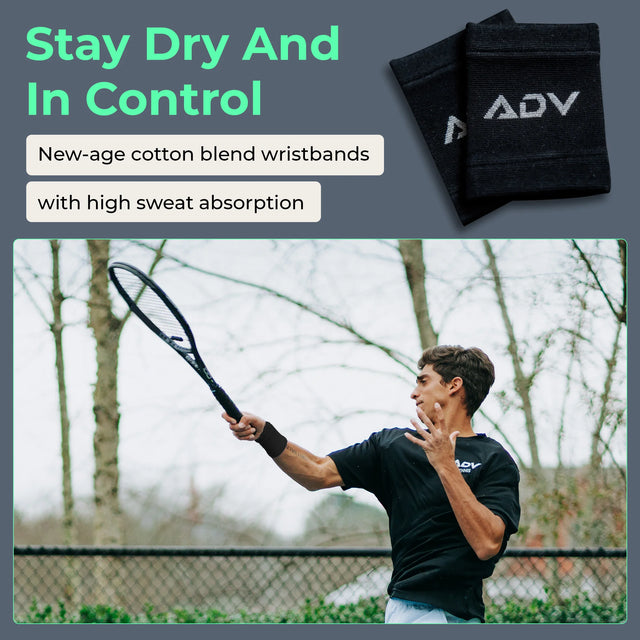Tennis Grips vs. Overgrips: Which Is Right for You?
Understanding the importance of a proper grip in tennis cannot be overstated—it's the critical link between the player and the racquet. A well-fitted grip can enhance the racquet's feel, giving the player greater control and confidence during strokes. Moreover, the right grip helps prevent injuries by reducing the strain on the wrist and forearm, allowing for more accurate and powerful shots. For both beginners and seasoned players, selecting the best tennis grips and overgrips is fundamental to adapting the racquet to one's personal style and needs.

Replacement Tennis Grips: The Foundation of Your Racquet
What Are These?
Replacement tennis grips serve as the base layer on a tennis racquet’s handle, directly wrapped around the racquet's bare handle. They are essential for providing the initial comfort and handling of the racquet. These grips are typically thicker and more durable than overgrips and are designed to offer a stable feel under intense play conditions. When choosing a grip, players must consider their playing frequency and the natural wear and tear on the grip to maintain optimal performance. The grip’s primary role is to enhance the player’s ability to hold onto the racquet during swings and serves, proving fundamental in achieving precise control and power.
The Materials
One of the most common options is synthetic grips, which have gained popularity due to their affordability, moisture-wicking properties, and overall versatility. These grips often feature textured surfaces that enhance grip security, making them ideal for players who sweat a lot or play in humid conditions. Synthetic grips are available in various thicknesses, allowing players to choose the level of cushioning that best suits their playing style. Their lightweight nature ensures they don’t add unnecessary bulk to the racquet, maintaining the player's ability to maneuver swiftly. For recreational players and beginners, these are often the go-to options as they strike a good balance between cost and functionality without compromising too much on durability or comfort.
Leather grips offer a more traditional and firm feel, appealing to experienced players who prefer a precise and direct connection with the racquet. Though they are less commonly used today, leather grips remain favored by those seeking maximum feedback during play. Leather, unlike synthetic materials, molds to the shape of the player's hand over time, creating a customized feel that improves with continued use. However, leather grips may lack the moisture-absorbing properties of synthetic options, which can make them slippery in hot or humid conditions unless paired with an overgrip. Players who opt for leather must also be prepared for regular maintenance, as leather grips require conditioning to prevent drying out and cracking.
For players who prioritize comfort, cushioned grips are an excellent choice, particularly for those who experience hand or wrist fatigue during long games. Cushioned grips are typically made from foam or gel-based materials that absorb shock and reduce the impact of each stroke on the player's joints. This extra padding can be a game-changer for individuals who play on hard courts or have pre-existing injuries, as it minimizes the strain placed on the hands and wrists. These grips are especially beneficial during extended rallies or long matches, as they help maintain comfort over time.
The Benefits
A well-chosen grip can prevent the quick deterioration of the racquet’s handle, a common issue with intense play. These grips are engineered to be durable, ensuring they can withstand multiple matches before needing replacement. Furthermore, the right grip can significantly reduce the risk of blisters and other hand discomforts, which are often caused by subpar or worn-out grips. This makes choosing a high-quality replacement grip a vital decision for serious players who spend long hours on the court.
How to Choose the Right One for Your Racquet
The grip's thickness and material affect the racquet's handle size and can change how the racquet feels during play. Players should consider their hand size, sweat levels, and typical weather conditions when choosing a grip. For players with larger hands or those who play in hot, sweaty conditions, a thicker and more absorbent grip might be ideal. Conversely, those seeking more racquet feedback might opt for a thinner, firmer grip. Testing different grips can provide insights into what works best for your game.
Tennis Overgrips: Customizing Your Feel
What Are Tennis Overgrips?
Thin layers wrapped over the base grip of a racquet, offering players the ability to fine-tune the handle’s feel and control, overgrips are lighter and less durable than replacement grips but provide essential benefits such as improved tackiness and sweat absorption. They are designed for easy replacement and are often used by players who need to adjust their grip frequently due to varying conditions or to prolong the life of the underlying replacement grip.
Preserve Your Racquet’s Original Grip
Since overgrips take on the brunt of wear from regular play, they act as a protective layer, shielding the more robust replacement grip from moisture and abrasion. This not only extends the life of the replacement grip but also maintains its effectiveness and comfort longer than it would otherwise last if exposed directly. Players can economically maintain their racquet’s handle by changing the best tennis overgrips for sweat frequently, avoiding premature wear of the more expensive replacement grips.
Grip Thickness: Finding the Perfect Fit
How to Measure and Select the Size
The process of selecting the right grip size requires careful consideration, as different aspects of play can be affected by this decision. By following the steps outlined below, you can make a more informed choice, leading to better overall performance and enjoyment in your game:
- Measure Your Hand: The first step in determining the ideal grip size is to measure your hand. Using a ruler or measuring tape, measure the distance from the middle crease of your palm to the tip of your ring finger. This measurement typically correlates with your optimal grip size and serves as a good starting point. A larger hand typically requires a thicker grip, while smaller hands may benefit from a thinner one. Ensuring that the grip matches your hand size will provide greater comfort and prevent strain on your muscles during extended play sessions.
- Consider Your Play Style: Your play style plays a significant role in grip selection. If you favor powerful shots, you might want to lean toward a thicker grip. A thicker grip allows for better control during forceful swings, helping to stabilize your racket and absorb impact. On the other hand, players who focus more on precision and finesse might prefer a thinner grip. A thinner grip offers more maneuverability, allowing for faster wrist movements and improved accuracy during delicate shots. Matching the grip to your style ensures optimal performance on the court.
- Test Different Grips: Before committing to a specific grip, it’s always wise to test various sizes. Visit a sporting goods store or borrow rackets from friends to try different grips. Pay close attention to how each grip feels in your hand and how it affects your play. Some grips may feel too bulky, while others might not provide enough support. Testing different options ensures that you find the perfect fit, one that provides both comfort and enhances your control over the racket.
- Seek Professional Advice: Consulting with a coach or a professional at a sporting goods store can offer valuable insights into grip selection. These experts can provide guidance based on their experience with various products and player preferences. They might also be able to analyze your swing and recommend a grip size tailored to your specific needs. Seeking professional advice can save you from potential trial and error, making the process of selecting the right grip size more efficient.
By measuring your hand, considering your play style, testing different grips, and seeking professional advice, you can make an informed decision. This thoughtful approach ensures that your grip not only complements your hand size but also enhances your overall performance, comfort, and enjoyment during play.

Common Issues
When it comes to the best tennis grips for comfort, choosing the wrong thickness can lead to several problems, impacting both play quality and player health. Here are the common issues associated with improper grip sizes:
- Reduced Control: A poorly fitting grip often leads to decreased control over the racket, resulting in less precise shots. When the grip is too small, the racket may rotate in your hand, causing the ball to go off-target. On the other hand, a grip that’s too large requires extra force to hold, which reduces the natural movement of the wrist and fingers, further hindering precision. This can also diminish a player's confidence in their shots, forcing them to adjust their playing style in less effective ways.
- Increased Fatigue: Playing with an incorrect grip size increases muscle tension, which directly leads to faster hand and forearm fatigue. A grip that is too small requires tighter clenching to maintain control, while a larger grip demands more strength to maneuver the racket. In both cases, players expend unnecessary energy, making it harder to sustain high performance throughout the match. As a result, fatigue sets in more quickly, leading to weaker shots and slower reaction times, especially during longer rallies or matches that stretch into multiple sets.
- Higher Risk of Injury: One of the most significant risks associated with using the wrong grip size is an increased chance of injury. Grips that are too small can lead to overuse of the wrist and fingers, potentially causing conditions like tennis elbow or wrist tendonitis. On the other hand, larger grips force players to compensate by straining muscles in the forearm and shoulder, increasing the likelihood of muscle fatigue and joint pain. Over time, these repetitive strains can lead to more serious, long-term injuries that might require extended recovery periods or even surgery.
In selecting the right grip size, players can improve their performance, increase endurance, and reduce the risk of injury. Taking the time to ensure proper grip fitting not only enhances gameplay but also contributes to long-term physical health on the court.
Sustainability in Grip Manufacturing
An emerging trend in the production of tennis grip options is the focus on sustainability. Manufacturers are now prioritizing the use of eco-friendly materials and processes to minimize environmental impact. This includes the use of recycled materials in grip production and innovations aimed at extending the life of the grip to reduce waste. Choosing sustainable grip options can contribute to environmental conservation while still enjoying the benefits of a high-quality product.
Where to Buy High-performance Tennis Overgrips
Selecting the Right Retailer
When looking to purchase the best tennis grips and top tennis overgrips, choosing the right retailer is crucial. Specialty sports stores often provide a wide range of options and the expertise of knowledgeable staff who can help you make an informed decision based on your specific needs. These stores typically offer a variety of brands and tennis grip types, allowing you to physically feel the grips before buying, ensuring the best match for your racquet and playing style.
Online Shopping for Convenience
For those who prefer the convenience of shopping from home, numerous online sports equipment retailers and e-commerce offer a vast selection of high-quality tennis overgrips and grips. Online stores often provide detailed product descriptions, customer reviews, and sometimes even virtual fitting tools to help you make the best choice.
Things to Consider When Buying
Whether you’re a seasoned player or just starting, taking time to evaluate your options can lead to a more satisfying tennis game. Let’s explore the key points to keep in mind when purchasing essential tennis grips and overgrips, ensuring that you make a well-informed decision that fits your needs:
- Product Range: Diversity allows you to find grips that align with your specific play style, whether you need extra cushioning, a tacky feel, or moisture-wicking properties. Different grips are designed for various conditions, so having multiple options at your disposal ensures you can experiment and identify what works best. A broader product range often includes brands that specialize in niche grip materials or innovative designs, giving you access to the latest technologies in grip manufacturing.
- Expert Advice: If you’re new to tennis or considering changing your grip, seeking expert advice can make a significant difference. Professionals at sporting goods stores or tennis coaches can recommend grips based on your hand size, playing surface, and grip pressure. Expert advice helps avoid the trial-and-error process that can occur when selecting grips on your own. They can explain the pros and cons of different materials, such as synthetic versus leather grips, and how these choices impact your game.
- Return Policies: Even after thorough research, you may find that the grip you purchase doesn’t perform as expected during gameplay. It could be too thick, too thin, or uncomfortable after extended use. A retailer with a good return policy allows you to return or exchange products that don’t meet your expectations. This assurance makes trying new grips less risky, as you know you have the option to find something that truly enhances your playing experience.
- Promotions and Discounts: Taking advantage of promotions, discounts, or bulk purchase options can lead to significant savings over time. Seasonal sales or clearance events are excellent opportunities to stock up on grips from trusted brands. Some retailers offer discounts for buying in bulk, which is a smart strategy for regular players who go through grips quickly. Keep an eye on special deals that can reduce your overall spending without compromising on quality.
Considering these factors can make your tennis grip shopping experience more efficient and satisfying. By investing in the right tennis handle grip and overgrips, you’ll enhance your game, comfort, and confidence on the court.

Selecting the ideal tennis grip or overgrip is a critical aspect of customizing your equipment to match your specific playing style and conditions. Whether you opt for durable tennis grips and overgrips, the choice significantly affects your comfort, control, and overall performance on the court. By carefully considering your personal needs—such as hand size, typical playing conditions, and personal preferences for comfort and tackiness—you can enhance your ability to execute shots with precision and confidence.



















